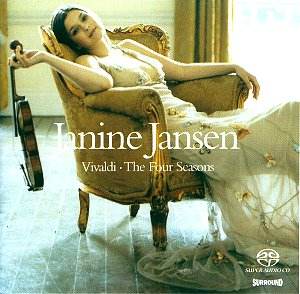Here is a distinguished
young Dutch violinist, already much
respected for her performances of a
wide range of works, making a bid in
the lucrative pop classics market. You
can tell that from the combination of
the cover of the CD and the musical
content. This is not the wet T shirt
approach but a more expensive sophisticated
one that plays on Ms Jansen's voluptuous
looks. As you can see from the cover,
she lounges - soft focused and back
lit - in a valuable looking piece of
furniture (a Louis Quinze antique perhaps?
- I'm no expert) swathed in yards of
delicately patterned diaphanous material
nonchalantly dangling a violin from
two fingers over the side of the chair.
If this is a Stradivarius (she does
own one) then it's, (a) a lot more valuable
than the chair and, (b) a risky manoeuvre.
She and Decca are presumably
hoping to emulate Nigel Kennedy whose
Four Seasons recording of nearly
twenty years ago gained an entry in
the Guinness Book of Records as the
highest selling classical recording
of all time. Kennedy had, shortly before,
committed to disc, two of the greatest
performances of the Elgar and Tchaikovsky
concertos ever recorded. His Four
Seasons was widely held by critics
to be one of the worst recordings of
the work ever made. The obvious moral
here is that you do not need to satisfy
the critics with a quality performance
that respects Vivaldi's original in
order to achieve smash hit status.
So it is largely down
to marketing. But what of the performance?
On seeing the cover of the disc and
before playing it, a friend said, "I
hope she sounds as good as she looks".
Well she does play very well, but not
as she looks. This is not voluptuous
solo playing but a clean, virtuosic,
spirited rendering low on vibrato. Not
only is she prettier than Nigel Kennedy
- at least I think so - but she
plays better in this work. It suggests
that with suitable accompanying forces
and a sensible, unified approach to
interpretation and recorded sound, she
could take part in a very fine performance
indeed, one that may satisfy the most
demanding critics. Overall though, this
is being sold on gimmickry. First of
all, Vivaldi's string orchestra is reduced
to one player per part. Jansen says
in the booklet that she had already
tried the approach with Bach and "found
it worked extremely well. So I decided
to give it a go with Vivaldi". So this
is not the result of recent revelatory
scholarship but an idea of her own.
There is not necessarily any harm in
that. Vivaldi tolerated all sorts of
rearrangements of this work during his
lifetime. The most extreme "reduced"
version was made after his death by
Jean-Jacques Rousseau no less (yes -
the philosopher) who arranged it for
unaccompanied flute. Rousseau had shortly
arrived in Venice and was thrilled to
hear Vivaldi played (as it was in the
composerís time) by string bands of
orphaned girls. It is pretty clear from
Rousseau's Confessions that the
thrill was not just musical.
Which brings me back
to Ms Jansen. Her band plays with astonishing,
brilliant precision and executes all
the eccentric mannerisms with unity
of purpose. It is perhaps not surprising
it sounds so well rehearsed because
this is partly a family affair. Dad
is at the harpsichord and brother on
the cello. They produce extremes of
dynamic and tempo even within single
movements, and although the string playing
is clean enough as to lean towards "authenticism",
much of the phrasing has a contradictory
romantic exaggeration to it together
with some hefty accentuation. Among
specific eccentricities are the repeating
pair of chords that accompany the beautiful
solo line in the slow movement of the
Spring concerto. These are stabbed
out in such a way as intrude on the
melody instead of accompanying it. In
the last movement of Summer there
are some pizzicato chords that make
a percussive snapping sound that I at
first thought might be a case of instrument
abuse Ė a broken bow perhaps. I donít
know how they achieved the effect.
All this is enhanced
by the recording engineers who must
have had a brief to exploit the SACD/surround-sound
technology. The bass seems to me to
be artificially boosted and the general
sound gets a treatment that in surround
will immerse you in a way quite at odds
with a chamber ambience.
One final quibble,
but a serious one. This is the first
disc Iíve come across for a long time
where I can find no figure for the total
playing time; not on the case, the disc
or in the booklet. It is hardly surprising
that Decca would wish to suppress the
information because the disc has half
the playing time of many others. Deccaís
website does own up to it as a "key
fact": 36.06 minutes. Some outlets
are selling it at full price. The cheapest
I can find is $21/£11. This can only
be described as a disgrace.
Call me a stuffy purist
but I cannot help thinking that if this
ensemble with Janine Jansen at its head
could have aimed at a performance that
had more of a respect for Vivaldiís
music than an eye on a lucrative market,
then a very fine, enduring result could
have been achieved that would make a
very convincing case for the reduced,
chamber forces. I have to confess though
that I was nearly seduced by it all,
and that has nothing to do with the
pictorial results of Ms Jansenís photo
shoot in the booklet.
John Leeman







